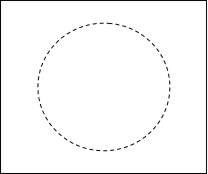Any harmonium has individual reeds which are played one after the other thus creating a real 'discontinuity' of notes (unlike string instruments like a Violin or Sarangi or Flute, where there are no 'steps' and continuity of notes is maintained).
Still, in actual concerts, this 'discontinuity' of harmoniums is not really bothersome.
How and why does this happen ?
The perception by the human brain follows certain laws. And, one of them is 'Law of Closure'. This means e.g., the circle drawn below actually is only a group of 'discontuous' lines. However, the brain (fills the gaps intelectually) and interpretes the diagram as a 'continuous' circle.
This is how, the discontinuous notes in harmonium appear to the brain as creating a continuous melody. This point is very important for all harmonium players.
The same thing happens in Tabla. The different Matras in a Taal actually are discontinuous, but the human brain interpretes the same as a continuous circle of a Taal. The same process happens in Santoor, Jala-taranga, Metallophone or any other instrument with independent notes.

